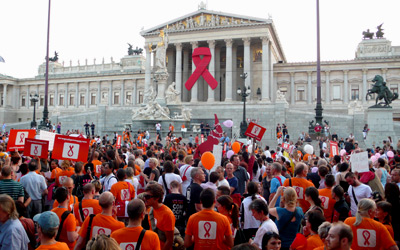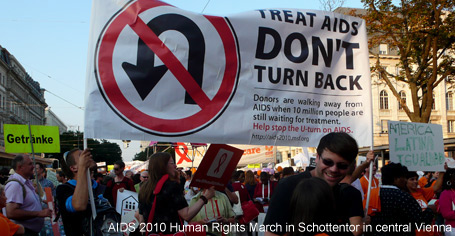The International AIDS Society’s 2010 Conference came to a close last Friday in the Austrian capital Vienna, after setting the tone for the next chapter in the fight against the virus that causes AIDS.
Increased access to treatment was one common goal shared among the estimated 20,000 conference delegates. Providing life-saving antiretroviral (ARV) treatment to everyone in need – based on current clinical guidelines – could result in a one-third reduction of new infections globally, a projection outlined in the UN’s latest strategic paper – dubbed “Treatment 2.0”.
Treatment as prevention
Viewing access to HIV treatment for 33-million people worldwide living with HIV (PLHIV) within the context of prevention strategies for the general population marks a significant shift from the current public health approach.
However the cost of scaling-up treatment, according to new World Health Organisation guidelines, would come at a high price. Stark differences of opinion on how this need would be met were clear sources of tension over the 6-day event.
Angry chants from protesters shouting “broken promises kill” peppered the opening plenary speeches – evidence of the deep-seated frustration among community workers and activists over the lack of funding and the persistent failure by politicians to deliver on their commitments.

Signs at the entrance of the Vienna conference site calling upon
Austrian President Heinz Fischer (and other leaders out of shot)
to continue to fund the global AIDS response
The stakes are high. The Global Fund To Fight AIDS, Tuberculosis and Malaria (also know simply as the Global Fund), the world’s largest mechanism for dispersing AIDS funds, is due for replenishment by this year. “We need US$20 billion by October this year to fund the next three years,” Global Fund Executive Director Michel Kazatchkine said to a crowd of thousands that gathered for a human rights rally in Vienna’s historic Heldenplatz district on the second night of the conference.
Among Asia’s donors to the Global Fund, Japan tops the list with over US$840 million contributed since 2001. China ranks second with US$12 million, followed by South Korea providing US$7.5 million over the same period. Thailand is one of three main Southeast Asian donors, providing US$6 million to the fund, then Singapore with US$1 million – paid between 2004 and 2007 – and Brunei Darussalam whose total contribution amounted to US$50,000 paid in 2007.
The United Nations, through its disease-response apparatus UNAIDS, has the ability to apply some pressure to governments, and UNAIDS Executive Director made the provocative suggestion that a tax on international transactions – dubbed the “Robin Hood Tax” – should be implemented worldwide to help ensure sustained streams of cash for health care. This was elaborated by advocate Khalil Elouardighi whose organisation Coalition PLUS has launched a petition calling for a micro-tax of 0.005-percent on financial transactions, which he says has the potential to generate US$33 billion annually worldwide.
However international pressure has its limits, thus leaving community groups and activists to form the backbone of movements to lobby and apply pressure on national governments to take action. Monetary and technical support for these grassroots entities – many of whom represent people most-affected by the HIV epidemic – was another key theme of the conference, as strategies for strengthening community-based organisations were reinvigorated after years of neglect.

AIDS 2010 Human Rights March, as the crowd passed an
appropriately dressed Austrian Parliament building
Know your drug war, reduce harm
The conference also saw intensified calls for policy makers and law enforcers to adopt codes of harm reduction in place of continued criminalisation of drug-use. The International Drug Policy Consortium and Transform Drug Policy Foundation – in association with the Open Society of billionaire investor and philanthropist George Soros – presented evidence that the global “war on drugs” is failing. Harm reduction advocates say that billions of dollars spent on “crackdown” tactics are wasted due to poor performance at reducing the prevalence of drug use. Furthermore, such tactics are reported to create a difficult environment for effective prevention and treatment of HIV, especially for injecting drug users.
The harm reduction issue was of such significance that the AIDS conference organisers sought wide support for a “Vienna Declaration” that stated “the criminalisation of illicit drug users is fuelling the HIV epidemic and has resulted in overwhelmingly negative health and social consequences.” The call for a complete overhaul of drug policies has so far received the support from over 13,000 signatories, including former presidents of Brazil, Colombia and Mexico, however the Canadian government, and other countries, have snubbed the declaration.
Novel approaches to prevention
The AIDS 2010 conference was also the venue for announcements on some promising news in the field of HIV prevention. While condoms are still heralded the most effective means of prevention, modest but significant progress has been made in the field of biomedical approaches.
Of note were findings from the CAPRISA initiative conducted in South Africa that investigated the efficacy of vaginal microbicide gels – when applied before and after sex – in preventing transmission of HIV. The study involving 900 women found 39-percent fewer HIV infections among those who used the gel when compared to those who used a placebo gel. Further studies will continue with research looking into concurrent oral administration of ARV medication – such as the ones used to treat people already living with HIV – that may provide greater protection. While the CAPRISA research shows significant impact for woman, initiatives are already underway to see how similar approaches can be applied to men who have sex with men.
Large-scale trials are underway in the Brazil, Ecuador, South Africa, Thailand and the US to assess if ARV-based medication can be used by HIV-negative men to help reduce the risk of transmission. Similarly, microbicide gels designed for anal sex are also being investigated. While there is a lot of optimism among researchers, the reality is that full-scale production of same-sex-oriented products would take at least another 10 years to become commercially viable, pending continued success within the current realms of research. In addition, observers are sceptical that such HIV prevention products, once in the market, would have a widespread impact, as they may only be accessible to those who can afford to pay the likely purchasing high cost.
For those that suffer the highest HIV infection rates – namely sex workers, injecting drug-users, gay men and other MSM – lack of awareness and education about one’s own risk – as well creating safe environments for everyone to access proper care, support and treatment – are still gravest of concerns, especially in the Asia-Pacific region.
Evidence in a report from the United Nations Development Program showed the adverse effect that punitive laws have on access to HIV prevention and treatment. Nine of 48 countries in the Asia Pacific region continue to criminalize male-to-male sex creating a difficult environment for an HIV response to be effective.
“Rights here, right now” was the clarion call for AIDS 2010 conference delegates, and until broad recognition of HIV as a human rights issue becomes a reality, little significant progress can truly be made in the war against AIDS.
Laurindo Garcia is Fridae’s HIV Programs Manager and correspondent based in Manila.












 Printable Version
Printable Version










Reader's Comments
Please log in to use this feature.